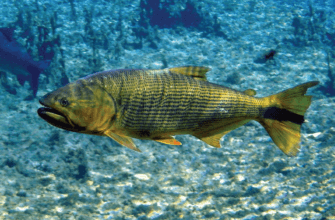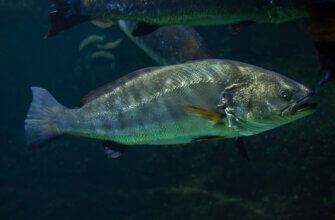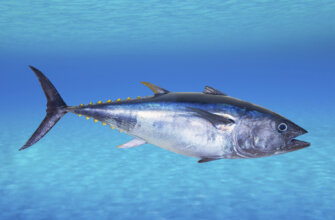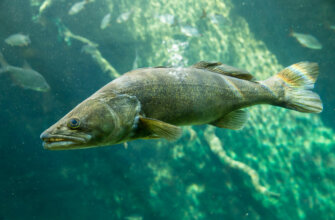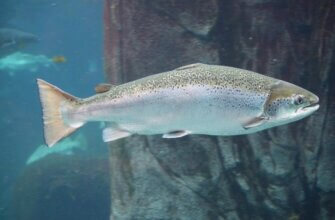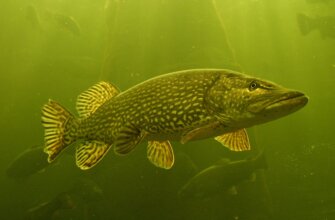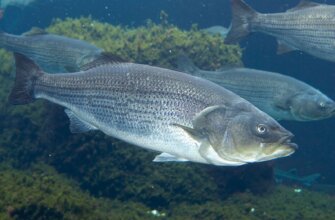Marlin is a type of large saltwater fish that is highly prized by sport fishermen and is also a popular food fish. There are several different species of marlin, including blue marlin, white marlin, black marlin, and striped marlin.
Marlins are known for their distinctive long, pointed bills, which they use to stun and catch prey such as squid, small fish, and crustaceans. They have a streamlined body and are incredibly fast swimmers, capable of reaching speeds of up to 60 miles per hour.
Blue marlin is the largest species, with some individuals reaching lengths of over 14 feet and weights of up to 1,800 pounds. White marlin, on the other hand, are smaller and typically weigh between 50 and 100 pounds.
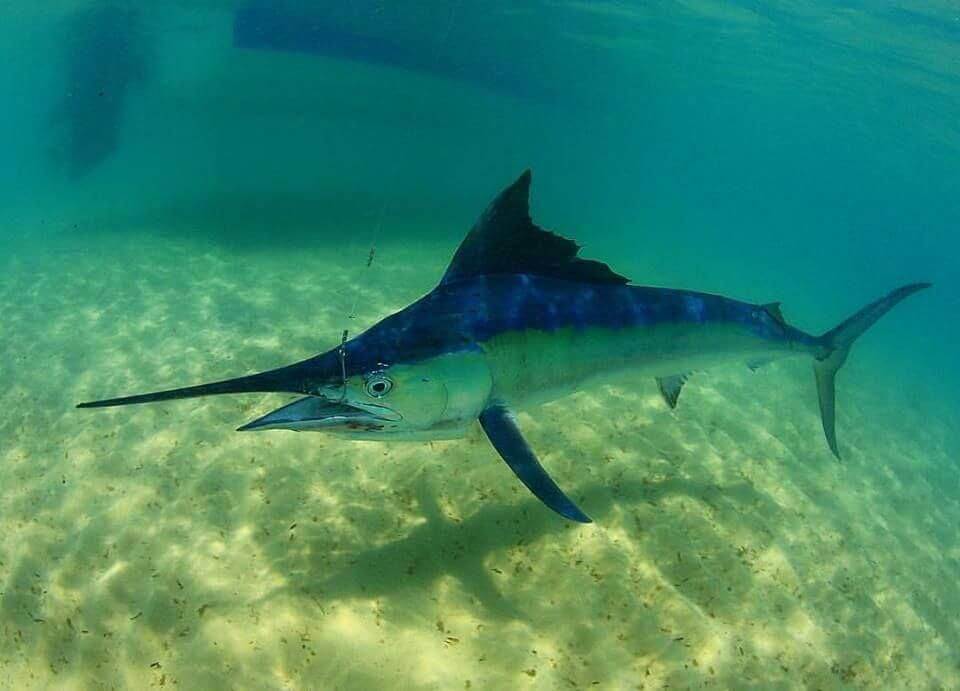
Marlins are found in warm waters around the world, including in the Atlantic, Pacific, and Indian Oceans. They are a popular game fish and are often caught by sport fishermen using techniques such as trolling, live baiting, and chumming.
In terms of food, marlin has a firm, meaty texture and a mild flavor. It is often grilled, broiled, or smoked, and is commonly used in sushi and sashimi dishes. However, due to overfishing concerns, some species of marlin are now considered threatened or endangered, and it is important to be mindful of sustainability when consuming this fish.
Species
There are several different species of marlin fish, each with its own unique characteristics.
The four main species of marlin are:
- Blue marlin (Makaira nigricans) – is a large, predatory fish found in the open waters of the Atlantic, Indian, and Pacific oceans. It is one of the largest fish species in the world, and is highly prized by anglers for its size, strength, and fighting ability.
- White marlin (Kajikia albida) – is a species of billfish found in the tropical and subtropical waters of the Atlantic Ocean. It is a popular game fish among anglers due to its impressive speed, fighting ability, and acrobatic jumps.
- Black marlin (Istiompax indica) – is a species of billfish found in the tropical and subtropical waters of the Indian and Pacific Oceans. It is one of the largest marlin species and is highly sought after by anglers due to its impressive size, speed, and strength.
- Striped marlin (Kajikia audax) – is a species of billfish found in the tropical and subtropical waters of the Pacific and Indian Oceans. It is highly valued by sport fishermen for its acrobatic jumps and strong fighting abilities.
All species of marlin are highly prized by sport fishermen due to their strength and agility. They are also a popular food fish, but some species are now considered threatened or endangered due to overfishing, habitat loss, and other threats. It is important to be mindful of sustainability when consuming marlin.
Appearance
Marlin fish have a distinct and recognizable appearance. They have a long, slender body with a pointed bill, also known as a rostrum. The bill is lined with sharp teeth that are used to stun and catch prey. The body of the marlin is covered with small scales and is typically blue-black or dark blue on the upper half, with a silver-white underside. The coloration of marlin may vary slightly depending on the species and its habitat.
The dorsal fin of a marlin is very distinctive, extending the entire length of the body and often tapering to a point at the end. The pectoral fins are relatively small compared to the size of the body, while the tail fin is large and crescent-shaped, giving the marlin tremendous swimming power.
Marlins are among the fastest swimmers in the ocean, capable of reaching speeds of up to 60 miles per hour. They have a streamlined body shape and powerful muscles that allow them to swim at high speeds and make sudden, agile turns.
The appearance of marlin can vary depending on the species and its size. Blue marlin are the largest and most iconic species, while white marlin and striped marlin are smaller and have distinctive markings. Black marlin are also very large and have a distinctive appearance, with a long, pointed bill and a sleek, black body.
Size and weight
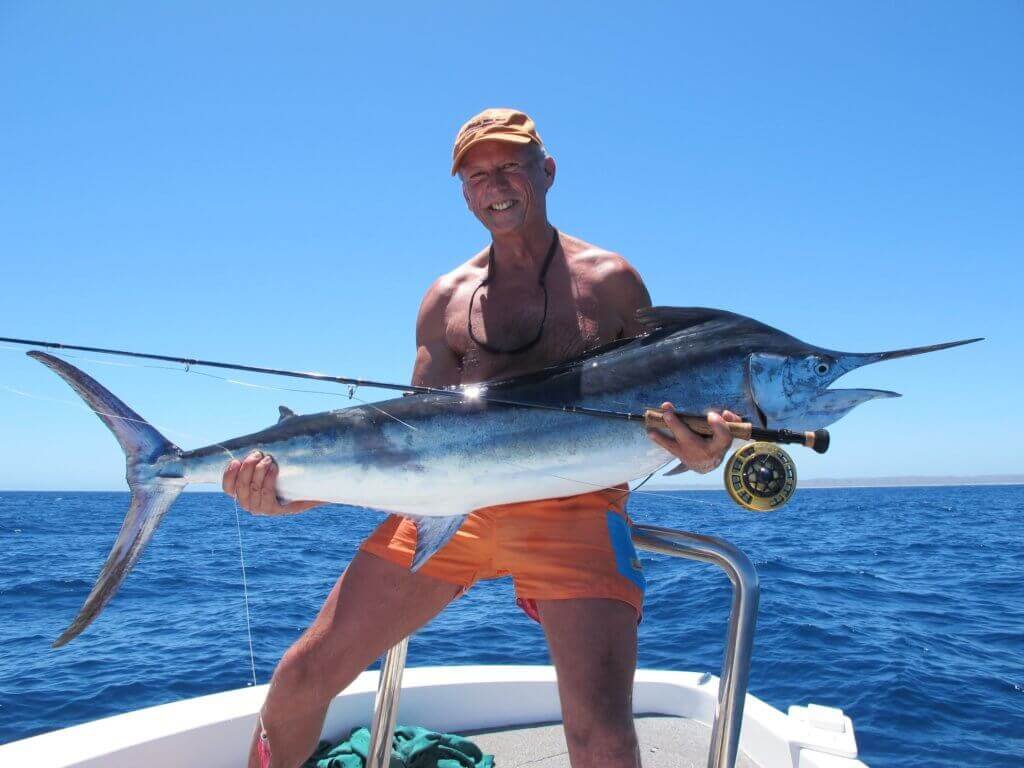
The size and weight of marlin fish can vary depending on the species and its habitat. Blue marlin are typically the largest species, while white marlin and striped marlin are smaller.
Here are some general size and weight ranges for the four main species of marlin:
- Blue marlin (Makaira nigricans) – Blue marlin are the largest species of marlin, with some individuals growing up to 14 feet long and weighing over 1,800 pounds. However, the average size of blue marlin caught by sport fishermen is typically between 200 and 400 pounds.
- White marlin (Kajikia albida) – White marlin are smaller than blue marlin, typically growing up to 8 feet long and weighing between 50 and 100 pounds. The average size of white marlin caught by sport fishermen is typically between 40 and 60 pounds.
- Black marlin (Istiompax indica) – Black marlin are similar in size to blue marlin, with some individuals growing up to 15 feet long and weighing over 1,500 pounds. However, the average size of black marlin caught by sport fishermen is typically between 200 and 500 pounds.
- Striped marlin (Kajikia audax) – Striped marlin are smaller than blue and black marlin, typically growing up to 9 feet long and weighing between 80 and 120 pounds. The average size of striped marlin caught by sport fishermen is typically between 100 and 150 pounds.
It is important to note that these are general size and weight ranges, and individual marlin may vary significantly in size and weight depending on factors such as age, gender, and habitat.
Diet
Marlin are apex predators, meaning they are at the top of the food chain in their oceanic ecosystems. They are opportunistic feeders and will eat a variety of prey, including fish, squid, and crustaceans. The specific diet of a marlin may vary depending on the species and its habitat.
Blue marlin are known to feed on a wide variety of fish species, including tuna, mackerel, and dorado, as well as squid and other cephalopods. They will often use their bill to stun or injure their prey before swallowing it whole.
White marlin are also known to feed on small fish species, as well as squid and other invertebrates. They will often hunt near the surface of the water, using their speed and agility to catch their prey.
Black marlin are known to feed on larger fish species, including tuna and mahi-mahi, as well as squid and other cephalopods. They are known for their incredible strength and will often put up a fierce fight when caught by fishermen.
Striped marlin primarily feed on small fish species, as well as squid and other invertebrates. They are known for their distinctive blue and silver stripes and are often hunted by sport fishermen.
Overall, marlin are powerful predators that play an important role in maintaining the balance of their oceanic ecosystems. However, some species of marlin are now considered threatened or endangered due to overfishing and other threats, highlighting the importance of sustainable fishing practices.
Behavior
Marlin fish are highly migratory and can travel thousands of miles across the open ocean. They are also known for their unique and interesting behaviors.
Here are some key behaviors of marlin:
- Swimming and Feeding. Marlin are powerful swimmers and can swim at high speeds to catch prey. They typically feed near the surface of the water, although some species will dive deeper to catch certain types of prey. Marlin often travel in schools and may hunt cooperatively to increase their chances of catching prey.
- Breaching. Marlin are known for their impressive aerial acrobatics, including breaching or leaping out of the water. This behavior is thought to be a way to dislodge parasites or to intimidate prey.
- Communication. Marlin use a variety of vocalizations to communicate with each other. These sounds can be used to attract mates, warn of danger, or coordinate group hunting behavior.
- Migration. Marlin are highly migratory and will travel long distances across the open ocean in search of food, breeding grounds, or more favorable water conditions. Some species of marlin will travel from the Pacific Ocean to the Atlantic Ocean or vice versa during their annual migration.
- Aggression. Marlin are known for their aggressive behavior when caught by fishermen. They will often put up a fierce fight, using their powerful muscles and sharp bill to try to escape.
Overall, marlin are fascinating and complex creatures with unique behaviors and adaptations that have evolved over millions of years to help them survive in their oceanic habitats.
Spawning
Marlin fish are known to be highly migratory and have a wide distribution across the world’s oceans. Different species of marlin spawn at different times and locations, depending on their specific habitat and environmental conditions.
Blue marlin, for example, typically spawn in the summer and fall in the western Atlantic Ocean, the Gulf of Mexico, and the Caribbean Sea. The eggs are fertilized externally and float in the open ocean until they hatch into larvae. The larvae then spend several months drifting in ocean currents before settling in shallow coastal waters, where they grow and mature.
White marlin spawn in the late spring and early summer in the western Atlantic Ocean, primarily in the Gulf Stream and the waters off the eastern coast of the United States. The eggs are also fertilized externally and float in the open ocean until they hatch into larvae. Like blue marlin, the larvae then spend several months drifting in ocean currents before settling in shallow coastal waters.
Black marlin are thought to spawn year-round in the Pacific Ocean, with peak spawning occurring in the summer months. The eggs are fertilized externally and float in the open ocean until they hatch into larvae. The larvae then spend several months drifting in ocean currents before settling in shallow coastal waters, where they grow and mature.
Striped marlin spawn in the summer and fall in the eastern Pacific Ocean, primarily off the coasts of Mexico and southern California. The eggs are fertilized externally and float in the open ocean until they hatch into larvae. The larvae then spend several months drifting in ocean currents before settling in shallow coastal waters.
Overall, marlin fish have complex and fascinating reproductive strategies that have evolved to help them successfully reproduce and survive in their oceanic habitats. However, some species of marlin are now considered threatened or endangered due to overfishing and other threats, highlighting the importance of sustainable fishing practices to ensure their continued survival.
Fishing
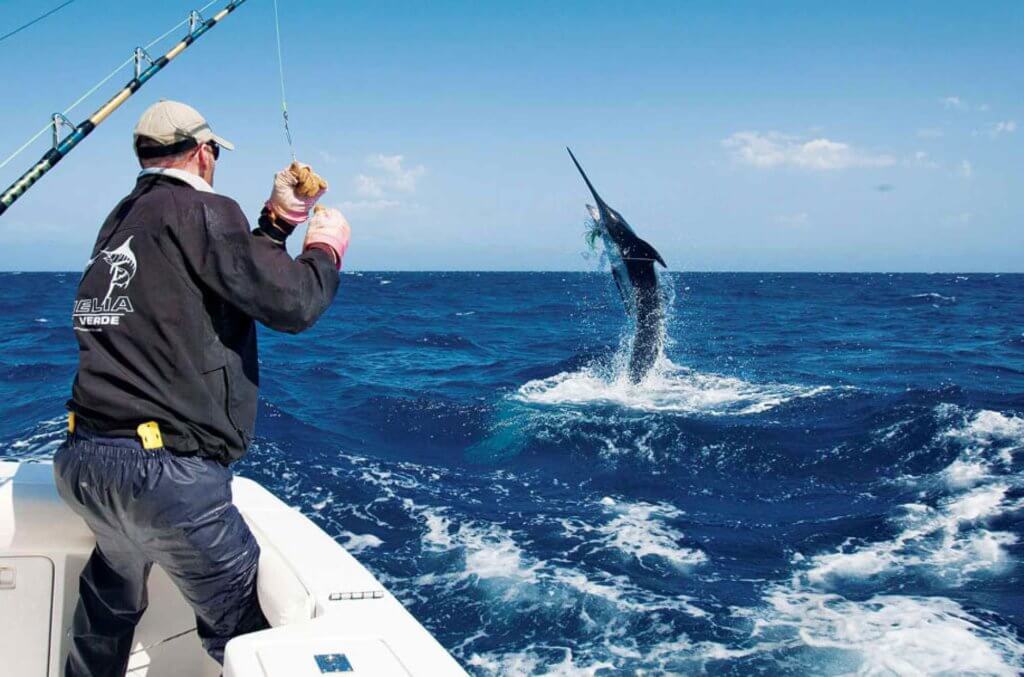
Fishing for marlin is a popular recreational activity around the world. Marlin are known for their size and strength, making them a challenging and exciting catch for sport fishermen. However, due to overfishing and other threats, some species of marlin are now considered threatened or endangered, so it is important to practice sustainable fishing practices when targeting marlin.
Here are some common techniques used for fishing marlin:
- Trolling. Trolling involves dragging a lure or baited hook behind a moving boat. Marlin are attracted to the movement and flash of the lure and will often strike it aggressively. Trolling can be done with various types of lures, including artificial lures and natural baits like squid or ballyhoo.
- Live Baiting. Live baiting involves using live fish as bait to attract marlin. This technique can be particularly effective for catching large marlin, as they often prefer live prey.
- Chumming. Chumming involves releasing small bits of fish or other food into the water to attract marlin to the area. Once the marlin are attracted, fishermen can then try to catch them using lures or baited hooks.
- Fly Fishing. Fly fishing for marlin is a challenging and exciting technique that involves casting a large fly that imitates a baitfish or other prey. This technique requires specialized gear and expertise but can be a rewarding way to catch marlin.
It is important to note that some species of marlin are now considered threatened or endangered, so it is important to practice catch-and-release fishing to help conserve their populations. When fishing for marlin, it is also important to use appropriate gear and techniques to avoid injuring the fish, as well as to follow local regulations and guidelines to ensure sustainable fishing practices.
Lures
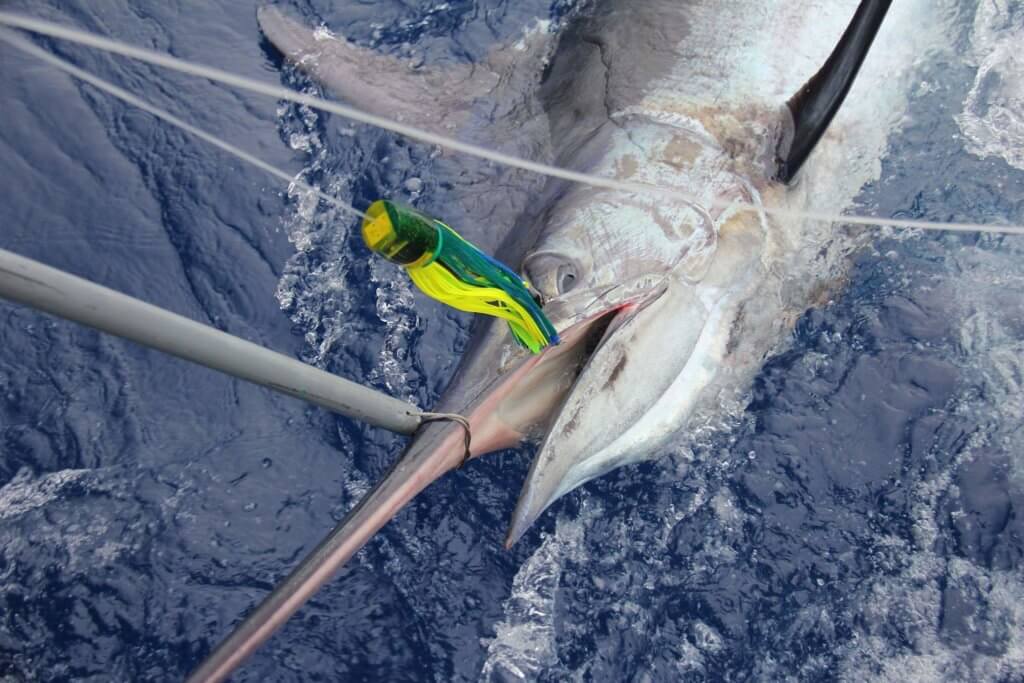
Marlin are known for their aggressive nature and are attracted to a variety of lures that mimic the movement and appearance of their natural prey.
Here are some common types of lures used for fishing marlin:
- Skirted Lures. Skirted lures are a type of artificial lure that consists of a colorful skirt that covers a hook or series of hooks. Skirted lures are designed to create a large splash and movement in the water, which can attract marlin from a distance.
- Swimming Plugs. Swimming plugs are hard-bodied lures that mimic the movement of baitfish or other prey. Swimming plugs are designed to dive and swim through the water, creating a realistic motion that can attract marlin.
- Soft Plastic Lures. Soft plastic lures are a type of artificial lure that consists of a soft, flexible body and a hook or series of hooks. Soft plastic lures are designed to mimic the texture and movement of natural prey, such as squid or octopus.
- Surface Poppers. Surface poppers are a type of artificial lure that creates a loud popping noise and splash when retrieved through the water. This can attract marlin that are hunting for prey on the surface of the water.
- Ballyhoo. Ballyhoo is a type of natural baitfish that is commonly used as a lure for marlin fishing. Ballyhoo is rigged with a hook and trailed behind a boat to create a natural movement that can attract marlin.
It is important to note that different types of lures may be more effective for different species of marlin, depending on their specific habits and feeding preferences. Additionally, it is important to use appropriate gear and techniques to avoid injuring the fish and to practice catch-and-release fishing to help conserve their populations.
There are many different types of fishing lures that can be used for Marlin fishing, and the specific models and specifications will depend on a variety of factors such as the fishing location, target species, and personal preference of the angler.
Here are some examples of popular Marlin fishing lures with their models and specifications:
- Moldcraft Wide Range Senior. This is a popular skirted lure for Marlin fishing that features a large, wide head and a long, slender body with a colorful skirt. It weighs 11 ounces and measures 14 inches in length.
- Rapala X-Rap Magnum. This is a hard-bodied swimming plug that is designed to mimic the motion of baitfish. It comes in a variety of sizes and colors, with the largest size weighing 6.5 ounces and measuring 7 inches in length.
- Williamson Live Ballyhoo Combo. This is a pre-rigged ballyhoo lure that features a realistic design and a weighted head for a natural swimming motion. It is available in several sizes and colors.
- Yo-Zuri Bonita. This is a hard-bodied swimming plug that is designed to mimic the movement of skipjack tuna, which is a common prey item for Marlin. It weighs 10 ounces and measures 8.5 inches in length.
- Halco Laser Pro 190. This is a hard-bodied swimming plug that features a slender, streamlined design and a lifelike finish. It weighs 6.5 ounces and measures 7.5 inches in length.
It is important to note that the effectiveness of these lures may vary depending on the specific fishing conditions and the behavior of the Marlin in the area. It is always recommended to do research and talk to local fishing experts to determine the best lures to use in a particular location.
Baits
In addition to lures, natural baits can also be effective for Marlin fishing.
Here are some examples of popular Marlin fishing baits with their models and specifications:
- Ballyhoo. Ballyhoo is a common baitfish that is often used for Marlin fishing. It can be rigged with a hook and trolled behind a boat to create a natural swimming motion. There are different types of ballyhoo baits available, such as the Islander Lure Ballyhoo or the Blue Water Candy Ballyhoo Rigged. These baits are typically around 6 inches long and come in a variety of colors and weights.
- Mackerel. Mackerel is another popular baitfish for Marlin fishing. It can be rigged with a hook and trolled behind a boat. There are different types of mackerel baits available, such as the Boone Bait Mackerel or the Sea Striker Mackerel Tree Rig. These baits are typically around 4-6 inches long and come in a variety of colors and weights.
- Squid. Squid is a common natural bait for Marlin fishing. It can be rigged with a hook and trolled behind a boat, or used as a teaser to attract Marlin to other lures or baits. There are different types of squid baits available, such as the Sea Striker Squid Skirts or the Squidnation Mauler Squid. These baits come in a variety of colors and sizes.
- Bonito. Bonito is a type of small tuna that is commonly used as bait for Marlin fishing. It can be rigged with a hook and trolled behind a boat, or used as a teaser. There are different types of bonito baits available, such as the Yummee Flying Fish or the Black Bart Bonito Candy. These baits are typically around 4-6 inches long and come in a variety of colors and weights.
- Skipjack Tuna. Skipjack tuna is another popular baitfish for Marlin fishing. It can be rigged with a hook and trolled behind a boat, or used as a teaser. There are different types of skipjack tuna baits available, such as the Yozuri Bonita or the Halco Max. These baits are typically around 6-8 inches long and come in a variety of colors and weights.
There are different types of baits that can be used for Marlin fishing, and the specific models and specifications will depend on a variety of factors such as the fishing location, target species, and personal preference of the angler.
Rods
When it comes to Marlin fishing, having the right fishing rod is crucial. A good Marlin fishing rod should be strong, durable, and capable of handling the weight and strength of these powerful fish.
Here are some features to look for in a Marlin fishing rod:
- Length. A typical Marlin fishing rod is between 5’6″ to 7′ in length. Longer rods provide more leverage and casting distance, while shorter rods provide more power and control.
- Power. Marlin fishing rods should have a heavy power rating to handle the weight of these fish. They should also have a fast action to provide enough backbone for hook sets.
- Material. Marlin fishing rods are typically made of high-quality materials such as graphite or fiberglass, which provide the necessary strength and durability.
- Guides. The guides on a Marlin fishing rod should be able to handle the weight and stress of heavy fishing line, and should be made of strong materials such as ceramic or stainless steel.
- Reel Seat. The reel seat on a Marlin fishing rod should be sturdy and able to handle the weight and torque of a heavy-duty reel.
Here are some examples of Marlin fishing rods:
- Shimano Terez TZCX66XXH: This rod is 6’6″ long, has a heavy power rating, and is made of high-quality graphite material. It also features Fuji K guides and a comfortable EVA handle.
- Penn Bluewater Carnage II: This rod is available in lengths ranging from 5’6″ to 7′, and has a heavy power rating. It is made of high-quality graphite composite material, and features Fuji guides and a comfortable EVA handle.
- Blackfin Tuna Rod by Melton International Tackle: This rod is 5’6″ long, has a heavy power rating, and is made of high-quality graphite material. It also features Fuji guides and a comfortable EVA handle.
- Okuma Makaira IGFA Stand Up Rod: This rod is 6′ long, has a heavy power rating, and is made of high-quality composite material. It also features ALPS guides and a comfortable EVA handle.
- Calstar Grafighter GFTR-765L: This rod is 6’6″ long, has a heavy power rating, and is made of high-quality graphite material. It also features Fuji guides and a comfortable EVA handle.
It’s important to note that the best Marlin fishing rod for you will depend on your personal preferences and the specific fishing conditions you will be facing. It is recommended to do research and talk to local fishing experts to determine the best fishing rod for your needs.
Dishes
Marlin fish can be cooked in various ways, depending on the preferences of the cook and the culture of the region. Here are some examples of dishes that can be made with Marlin fish:
- Grilled Marlin. Marlin fish can be grilled with a simple seasoning of salt, pepper, and garlic or with a more complex marinade that includes herbs, citrus juice, and soy sauce. The fish is grilled until it is golden brown on the outside and tender on the inside.
- Marlin Ceviche. Marlin fish can be used to make a delicious ceviche, which is a popular dish in many Latin American countries. The fish is marinated in lime juice, onion, cilantro, and other seasonings until it is cooked by the acid in the lime juice.
- Marlin Tacos. Marlin fish can be used to make tasty fish tacos, which are a popular dish in many coastal regions. The fish is seasoned with cumin, chili powder, and other spices and then grilled or fried. It is then served in a tortilla with fresh vegetables and a variety of sauces.
- Marlin Kabobs. Marlin fish can be cut into chunks and skewered with vegetables and grilled on the barbecue. The kabobs can be seasoned with a variety of spices and served with rice or other side dishes.
- Marlin Steaks. Marlin fish can be cut into steaks and pan-fried or grilled. The fish is seasoned with salt, pepper, and other seasonings and served with a variety of side dishes, such as rice, vegetables, or potatoes.
It’s important to note that Marlin fish is a popular game fish that is often caught and released. Before preparing Marlin fish for consumption, it’s important to check the local fishing regulations and to ensure that the fish is safe to eat.

